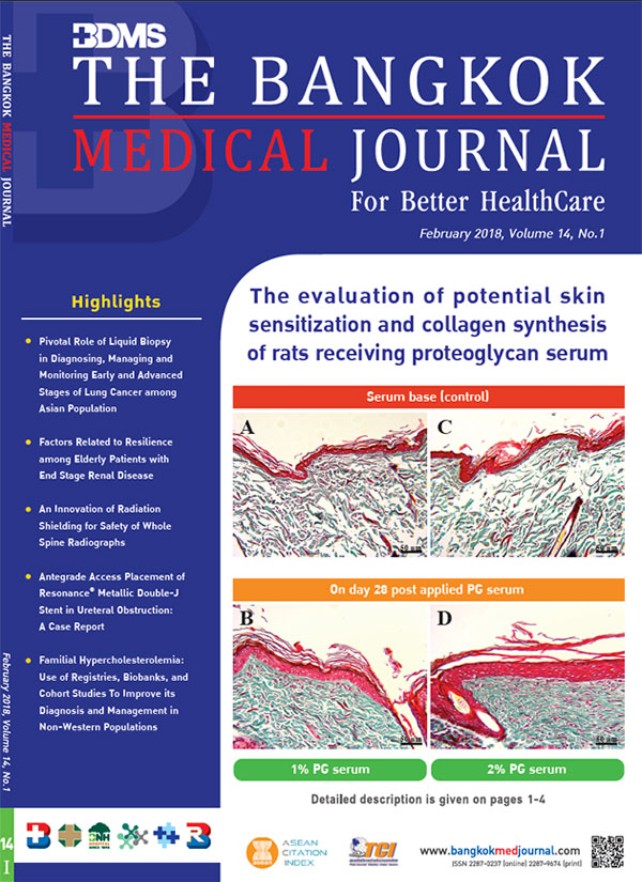Dabigatran, fears in doctors’ minds.
Main Article Content
Abstract
The fact that many doctors still refuse to replace the anticoagulant warfarin with dabigatran, despite dabigatran’s better safetyprofile, is not a scientific problem but a psychological one. In my view there are four fears in doctors’ minds:
Article Details
How to Cite
1.
Chaiyodsilp S. Dabigatran, fears in doctors’ minds. BKK Med J [internet]. 2018 Feb. 20 [cited 2025 Dec. 27];14(1):88. available from: https://he02.tci-thaijo.org/index.php/bkkmedj/article/view/222444
Section
Letter to The Editor
This is an open access article distributed under the terms of the Creative Commons Attribution Licence, which permits unrestricted use, distribution, and reproduction in any medium, provided the original work is properly cited.
References
1. US Food and Drug Administration. FDA Drug Safety Communication: Safety review of post-market reports of serious bleedingevents with the anticoagulant Pradaxa (dabigatran etexilate mesylate).2012 (Accessed September 13, 2017 at https://www.fda.gov/drugs/drugsafety/ucm282724.htm).
2. Australian Government, Department of Health and Aging, Therapeutic Goods Administration. Dabigatran (Pradaxa) and risk ofbleeding: Information for health professionals. 2013 (Accessed September 13, 2017 at https://www.tga.gov.au/alert/dabigatranpradaxa-and-risk-bleeding-information-health-professionals).
3. The Japanese Ministry of Health, Labor, and Welfare. Safety advisory of the potential for adverse events with dabigatran, November3, 2011. (Accessed September 13, 2012 at http://www.theheart.org/article/1264365.do).
4. Connolly SJ, Ezekowitz MD, Yusuf S, et.al. Dabigatran versus Warfarin in Patients with Atrial Fibrillation. N Engl J Med 2009;361:1139-51.
5. Camm AJ1, Lip GY, De Caterina R, et al. 2012 focused update of the ESC Guidelines for the management of atrial fibrillation: anupdate of the 2010 ESC Guidelines for the management of atrial fibrillation. Developed with the special contribution of the EuropeanHeart Rhythm Association. Eur Heart J 2012;33(21):2719-47.
6. Tomimori H, Yamamura N, Adachi T, et al. Pharmacokinetics, safety and pharmacodynamics after multiple oral doses of dabigatranetexilate capsule (110 mg and 150 mg b.i.d., 7 days) in healthy Japanese and Caucasian male subjects: An open label study. Studyno. 1160.61. Report no. U06-3420. Boehringer Ingelheim Internal Report, 2006.
7. Pollack CV Jr, Reilly PA, van Ryn J, et al. Idarucizumab for Dabigatran Reversal - Full Cohort Analysis. N Engl J Med 2017;377:431-41.
2. Australian Government, Department of Health and Aging, Therapeutic Goods Administration. Dabigatran (Pradaxa) and risk ofbleeding: Information for health professionals. 2013 (Accessed September 13, 2017 at https://www.tga.gov.au/alert/dabigatranpradaxa-and-risk-bleeding-information-health-professionals).
3. The Japanese Ministry of Health, Labor, and Welfare. Safety advisory of the potential for adverse events with dabigatran, November3, 2011. (Accessed September 13, 2012 at http://www.theheart.org/article/1264365.do).
4. Connolly SJ, Ezekowitz MD, Yusuf S, et.al. Dabigatran versus Warfarin in Patients with Atrial Fibrillation. N Engl J Med 2009;361:1139-51.
5. Camm AJ1, Lip GY, De Caterina R, et al. 2012 focused update of the ESC Guidelines for the management of atrial fibrillation: anupdate of the 2010 ESC Guidelines for the management of atrial fibrillation. Developed with the special contribution of the EuropeanHeart Rhythm Association. Eur Heart J 2012;33(21):2719-47.
6. Tomimori H, Yamamura N, Adachi T, et al. Pharmacokinetics, safety and pharmacodynamics after multiple oral doses of dabigatranetexilate capsule (110 mg and 150 mg b.i.d., 7 days) in healthy Japanese and Caucasian male subjects: An open label study. Studyno. 1160.61. Report no. U06-3420. Boehringer Ingelheim Internal Report, 2006.
7. Pollack CV Jr, Reilly PA, van Ryn J, et al. Idarucizumab for Dabigatran Reversal - Full Cohort Analysis. N Engl J Med 2017;377:431-41.


